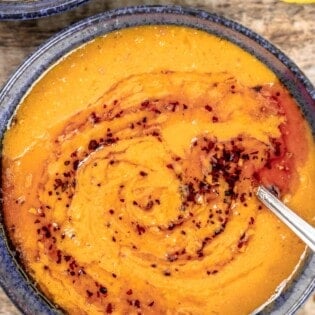Simit is an easy-to-make Turkish bread coated in sesame seeds. Sometimes called a Turkish Bagel, this simit recipe is delicious on its own, or sliced in half to make a sandwich. Serve it as part of a breakfast, lunch or brunch spread.

I adore simit and it really is the quintessential Turkish street food; these sesame-encrusted bread rings are no doubt the most popular snack in my homeland Turkey. Coated with golden sesame seeds, Simit has a crunchy outside and soft, pull apart inside.
I just can’t decide which I like more — simit or Turkey’s favorite sweet treat, Lokum also known as Turkish Delight. To be honest, I think you should make both!
Serve simit for breakfast with Menemen, Shakshuka or Soft Scrambled Eggs along with some vegetables like cucumbers and tomatoes. Or enjoy it with your favorite snacks and spreads like marinated feta and labneh. If you have a bit of a sweet tooth or just like to keep it simple a drizzle of honey or spread of jam is equally delicious.
Although, I no longer live in Turkey, every time I make this Simit recipe or teach the process in my cooking classes, it brings me right back to the streets of my homeland. It really is easy to make this beautiful bread once you get the hang of shaping it.

Table of Contents
What Ingredients are Needed to Make Simit:
Like most breads the ingredient list is pretty simple, but there is one ingredient that may be difficult to come by — Grape molasses, üzüm pekmezi. It’s a type of syrup made from the juice and must of certain fruits, usually grapes or figs.
In the event, that you can’t find grape molasses then date, fig or carob molasses would work. You can find them in Turkish, Greek, Middle Eastern or Mediterranean specialty stores. If you are really in a bind, use regular molasses available in large grocery stores, but the flavor would be different.
- Sugar: I use just a small amount to help the yeast wake up.
- Active dry yeast: Make sure when you add water to the yeast that it foams. That’s how you know it’s alive and your bread will rise. If the yeast doesn’t get foamy after 5 minutes it might be time for new yeast.
- All purpose flour: This flour is readily available for most people and it works great for making this simit recipe.
- Sea salt: I like sea salt, but if you only have Kosher salt that will work just fine here.
- Grape molasses (date, fig or carob molasses can also be used): This adds color to the dough, a little earthy sweetness, and helps the sesame seeds adhere to the simit.
- Golden sesame seeds: These add that nutty flavor and crunchy texture to simit. If you like sesame bagels or Jerusalem bagels you will love Simit.

How Do You Make Simit
Making these Turkish bagels starts out like making most breads – bloom a little yeast then combine it with flour, and let it rise. The fun part starts when you shape the dough into ropes and twist them together.
1. Bloom the yeast: Into a medium bowl, combine the sugar and 1 1/2 cups lukewarm water (between 90-110°F). Add the yeast, mix with a small spoon and set aside for 5 to 8 minutes, until the yeast becomes foamy.
2. Make the dough: Into a large bowl, add the flour and salt. Stir to combine then make a well in the center. Add the yeast mixture and stir to form a coarse dough.
3. Knead the dough: Turn out onto a lightly floured surface and knead for about 5 minutes, or until the dough is smooth and elastic. Roll the dough into a ball and place in a lightly oiled bowl, turning to coat. Cover with plastic wrap or a kitchen towel and set aside in a warm, draft-free place for 45 minutes to 1 hour, or until doubled in size. A sunny spot on your countertop is perfect.
3. Preheat the oven, prepare the baking sheets and dipping station: Preheat the oven to 400°F. Line 2 large baking sheets with parchment paper. Combine the grape molasses, with the remaining water and whisk together. Pour the sesame seeds onto a large plate. Set it next to the bowl of molasses water.
4. Deflate and shape the dough: Dump the dough onto a lightly floured work surface. Stick your fist in the center of it to deflate or knock back the dough. Shape it into a ball. Divide the dough ball into 8 even sized pieces.
5. Cut and Stretch the dough: Working with one piece of dough at a time, use your hands to roll each dough segment into a long rope about 24-inches long. The dough is sturdy so you can apply gentle pressure as you roll and stretch the rope. I tend to work with my hands side by side in the center of the dough. Than, while rolling the dough back and forth I slowly separate my hands as the dough lengthens.
6. Twist the dough: Fold each rope in half so two ends align. Then use your hands to twist it into a two stranded “rope.” Join the ends together to make a circle, and press them firmly together to seal the circle. Gently shape the area where you pressed the ends together to make it rounded and not flat. Repeat with the remaining dough. In the end you should have 8 twisted rope circles.
7. Dip each ring: Dip each ring, first into the molasses mixture, submerging it completely. If you don’t have enough liquid to submerge it, flip it over so both sides are coated. Once the bread is coated, remove it from the molasses mixture, gently shaking off any excess. Set the bread ring in the sesame seeds, turn gently to coat both sides. Transfer to the prepared tray and set aside at room temperature for about 15 minutes, to puff slightly. Repeat with the remaining ropes.
8. Bake: Place the baking sheet in the pre-heated oven for 20 minutes or until deep golden brown and cooked through. Transfer to a wire rack to cool.
Tips and Tricks for Making Simit
Have fun! It really is easier than you think to make this simit recipe at home. And when all is said and done it feels like a hugely satisfying accomplishment. Pay attention to the shaping instructions in the recipe and make it your own. As always, practice makes it better!
- Believe it or not yeast is a living organism and if your water is too hot it will kill the yeast. So, when making this simit recipe make sure the water isn’t hotter than 110°F.
- Provide a warm environment for the simit dough to proof. In light of having an actual proofing oven, you can place the dough bowl near a preheated oven or in a sunny spot on our counter.
- Shaping the simit is fun and you’ll only get better with practice! Although this twisted dough might look complicated, I can assure you it is not. Once you get the hang of it you can move pretty quickly. Work on a clean, dry, lightly floured large surface. After you’ve made a rope of bread, fold it in half so two ends align and use your hands to twist each piece into a two stranded “rope”. Join the ends together to make a circle, pressing the ends firmly together to seal. I promise you will be a pro simit maker after a few practices easily!
- When street vendors in Turkey sell simit it’s usually a little larger and slimmer. If you want to make it that way, gently stretch the dough circle a little wider with your hands after its been coated in the sesame seeds.

Simit Variations
The word “simit” derives from “ring of flour” and there are variations throughout Turkey, though this sesame version is the most popular. Let creativity be your guide and add your own flair to this recipe.
Although, seeds like sesame are common, you can also fold chopped olives and herbs (dried or fresh) to the dough. And don’t be afraid to play with the shape. Once you get the hang of it go beyond a circle and try a rectangle where melting cheddar cheese and or slices of Turkish dried cured beef can be inserted in the middle and baked.
In Turkey you can also find these variations on simit:
- Gevrek: a crusty kind of simit often made without sesame seeds
- Catma: a twisted version
- Kandil simiti: are smaller, crispier bread rings made during religious muslim holy nights
How to Enjoy Simit
For us Turks, simit is a much loved all day snack. You can have simit as an afternoon snack with ayran (Turkish salty yogurt drink), or for breakfast with a cup of çay (Turkish tea), sliced cucumber, tomatoes, beyaz peynir (our feta) and olives.
One of my most fond memories is to have simit and cup of Turkish tea, cay, on the ferry, in Istanbul, traveling between the both sides of the city.
As the ferry slowly moves along the Bosphorus Strait, having a bite of simit and a sip of tea, with the wind in my face and the fascinating sites in front of me, is a magical moment. I try to recreate this special experience each time I visit Istanbul.
Turks mostly prefer savory accompaniments to simit, which is why it makes a lovely sandwich bread! To make a simit sandwich, slice the bread horizontally and stuff with thin slices of feta (or your favorite cheese), tomato, and cucumber. Once you drizzle a little olive oil over and top for the finishing touch and add the other half of simit you’ll sign on for the duration — it is absolutely divine!
More Turkish Recipes
Browse all Mediterranean recipes.
Visit Our Shop.
The Mediterranean Dish Cookbook
The Mediterranean Dish Cookbook: 120 Bold and Healthy Recipes You’ll Make on Repeat. In her book, Suzy brings cross-culturally inspired dishes from throughout the Mediterranean to you, using easy-to-find ingredients and easy-to-follow, to make your meals more vibrant, delicious, and yes — even a little healthier, too!

Simit (Turkish Sesame Bread Rings)

Ingredients
- 1/4 teaspoon sugar
- 1 tablespoon active dry yeast
- 1 3/4 cups lukewarm water, divided
- 4 cups (510 g) all purpose flour
- 2 teaspoons sea salt
- 1/2 cup grape molasses, date, fig or carob molasses can also be used
- 4 tablespoons water, combined with the grape molasses
- 2 cups (5 ounces) golden sesame seeds
Instructions
- Bloom the yeast: Into a medium bowl, combine 1/4 teaspoon sugar and 1 1/2 cups lukewarm water (between 90-110°F). Add the yeast, mix with a small spoon and set aside for 5 to 8 minutes, until the yeast becomes foamy.
- Make the dough: Into a large bowl, add the flour and salt. Stir to combine then make a well in the center. Add the yeast mixture and stir to form a coarse dough.
- Knead the dough: Turn out onto a lightly floured surface and knead for about 5 minutes, or until the dough is smooth and elastic. Roll the dough into a ball and place in a lightly oiled bowl, turning to coat. Cover with plastic wrap or a kitchen towel and set aside in a warm, draft-free place for 45 minutes to 1 hour, or until doubled in size. A sunny spot on your countertop is perfect.
- Preheat the oven, prepare the baking sheets and dipping station: Preheat the oven to 400°F and line 2 large size baking sheets with parchment paper. Combine the grape molasses, with the remaining 1/4 water in a large bowl, and whisk together. Pour the sesame seeds onto a large plate. Set it next to the bowl of molasses water.
- Deflate and shape the dough: Dump the dough onto a lightly floured work surface and stick your fist in the center of it to deflate or knock back the dough. Shape it into a ball and divide into 8 even sized pieces.
- Cut and Stretch the dough: Working with one piece of dough at a time, use your hands to roll each dough segment into a long rope about 24-inches long. The dough is sturdy so you can apply gentle pressure as you roll and stretch the rope. I tend to work with my hands side by side in the center of the dough, rolling the dough back and forth and separating my hands as the dough lengthens.
- Twist the dough: Fold each rope in half so two ends align and use your hands to twist it into a two stranded “rope.” Join the ends together to make a circle, and press them firmly together to seal the circle. Gently shape the area where you pressed the ends together to make it rounded and not flat. Repeat with the remaining dough. In the end you should have 8 twisted rope circles.
- Dip each ring: Dip each ring, first into the molasses mixture, submerging it completely. If you don’t have enough liquid to submerge it, flip it over so both sides are coated. Remove it from the molasses mixture, gently shaking off any excess. Set the bread ring in the sesame seeds, turn gently to coat both sides. Transfer to the prepared tray and set aside at room temperature for about 15 minutes, to puff slightly. Repeat with the remaining ropes.
- Bake: Place the baking sheet in the pre-heated oven for 20 minutes or until deep golden brown and cooked through. Transfer to a wire rack to cool.
Notes
- Visit our shop to browse quality Mediterranean ingredients including olive oils, honey, jams and spices.
- Substitutions for the grape molasses, pekmez: Grape molasses, üzüm pekmezi is traditionally used in making simit. Pekmez is a molasses-like syrup made from the juice and must of certain fruits, usually grapes or figs. If you can’t get grape molasses, then date, fig or carob molasses would work too. You can usually find these in Turkish, Greek, Middle Eastern or Mediterranean specialty stores.
- Savory flavors are great with Simit, but sweet is too. Make a batch of simit then try it with our jam and honey.









Can I use pomegranate molasses?
Sure, Shelina! You can use pomegranate molasses here. Just be aware, it’s not as sweet as grape molasses.
These look so good! Would love to try this recipe (love all your recipes). We are gluten free, any advise on the flour to use or changes to the recipe to make it happen? Would love your help and input.
Hi, Suzi. Unfortunately, we haven’t tested this recipe using gluten free flour, so it’s hard to give specific input. You may be able to us a 1:1 Gluten Free Baking Flour like this. If you decide to give it a try, please stop back and share your thoughts! We’d love to know how well it worked!